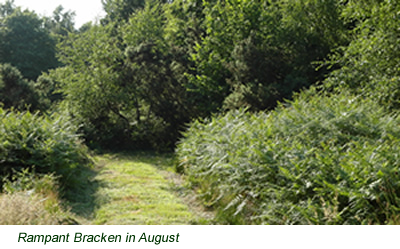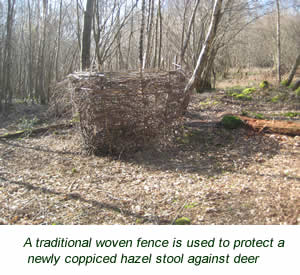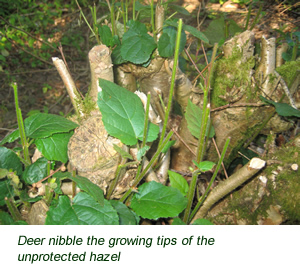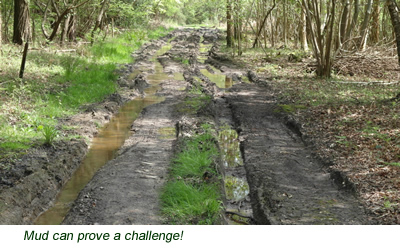Coppicing Challenges
Bracken
Bracken is very persistent and is encouraged by the light in the more open areas of the woodland. We keep its growth under control annually but retain some as it is an important habitat for invertebrates and other wildlife. We cut the bracken by hand and do not employ the use of chemicals to control it.
Deer
Deer like to eat the new growth of coppiced trees. They nibble off the top of the growing point of the new stalks ,if this happens regularly the damage can kill the stool. There are a number of deer living near Noor Wood and if we want the coppiced tree and the plants around it to regenerate,we will have to take measures to protect them.

 We have successfully used a tradtional woven fence around the individual stools and will be fencing off some small areas with a 'dead hedge' (a fence made of brash and branches). Both of these methods take along time and are only useful for small areas.We will install temporary plastic deer fencing to larger areas once they have been coppiced.
We have successfully used a tradtional woven fence around the individual stools and will be fencing off some small areas with a 'dead hedge' (a fence made of brash and branches). Both of these methods take along time and are only useful for small areas.We will install temporary plastic deer fencing to larger areas once they have been coppiced.
Ticks
Where deer are present in woodlands there is always the threat of contracting Lyme Disease from the ticks they carry. These tiny creatures live in the bracken and jump onto passing deer, dogs and humans to feed on their blood. When working with bracken, particularly in the summer, we have to be especially careful to wear protective clothing and check for tick infestation. As you might imagine, ‘bracken bashing’ is not one of our favourite tasks!
Access
Access to Noor Wood is down a shared track which, at certain times of the year, can be quite difficult to negotiate because of the mud. A 4 x 4 is essential!
Dogs
Noor Wood is adjacent to other woodland plots, one of which is available for public access. Whilst it is wonderful to see people enjoying the woods, their dogs can sometimes pose a threat to wildlife. Hibernating dormice are easily disturbed by dogs rooting around at the base of trees and in the undergrowth. We therefore ask their owners to respect the sanctity of our woodland by keeping their pets under control.
